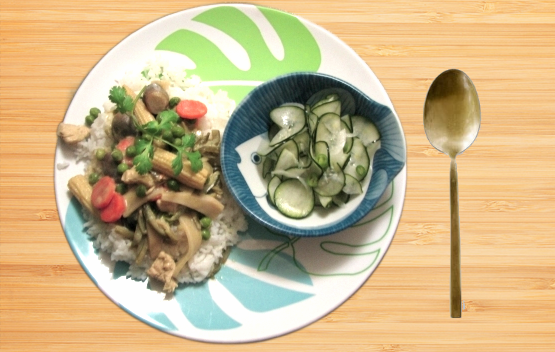
The recipe below is one of our favorites. It is easy to prepare but is wonderfully delicious and very good for entertaining guests. The curry can be cooked in either a wok or a large saucepan. All of the ingredients for this dish can be purchased at the 99 Ranch Market.. It's a good idea to read through the entire recipe to get a sense of the variations possible.
Ingredients:
- 2 chicken breasts sliced 1/4 in thin in medium sized pieces.
- 2 tablespoons peanut or corn oil
- 2 (14 ounce) cans coconut milk or cream
- 1 stalk of lemongrass
- 4 kaffir lime leaves
- 1-4 tablespoons of Aroy-D curry paste (Green or Panang)
- 2 tablespoons of grated fresh ginger
- 1 tablespoons of fish sauce (optional)
- 1 (8 ounce) can of bamboo shoots
- 1 (14 ounce) can of baby corn
- 1 (14 ounce) can of straw mushrooms
- 1/3 pound frozen peas
- 1/2 pound sliced green beans
- 1/3 pound sliced carrots
- 1 teaspoon salt
- Tender sprigs of cilantro
- 2 cups jasmine rice
- 3 cups water
Preparation:
- Start cooking the rice first in a rice cooker or in a pot. Jasmine rice requires slightly less water than American long-grain rice.
- Sauté the chicken in the oil on medium-high heat for 2 minutes.
- Add the ginger and the optional fish sauce. Uncooked fish sauce is very aromatic (fishy) before it is fully cooked, don't worry about this as it tempers down during cooking.
- Cook the chicken until it is fully cooked, but only very lightly browned. Add the curry paste (adjusting for your tolerance for chilies), mix well and cook for another minute or so. Both green curry paste (hotter) and Panang curry paste (sweeter) work well with chicken. Try both (but not in the same dish!) You can also substitute firm white fish (like cod) or shrimp for the chicken.
- The lemongrass and lime leaves are optional but they really do impart wonderful flavors to the dish. Cut off or peel the dried out parts of the lemongrass stalk and then mutilate it with a kitchen hammer or the back side of a cleaver. Break the lemongrass in one or more places so that the flavors infuse the curry. Please note that the lemongrass and the kaffir lime leaves are for flavoring the curry; it is not recommended that you eat them!
- Add the coconut milk or cream to the sauce pan or wok. Coconut milk yields a thinner sauce; many restaurants use coconut cream to create a very thick sauce.
- Add all of the remaining ingredients except the cilantro and simmer softly until all the carrots are tender, but not over-cooked. I often use frozen French-cut green bean instead of fresh. Asian eggplants and potatoes also work well in this recipe, but if you use them you must be very careful not to overcook them.
Serve over rice, garnished with small tender sprigs of cilantro.
Thai Cucumber Salad Ingredients:
- 1 cucumber, either diced small or sliced thin
- 1-4 hot Thai chilies, sliced very thin
- 1/4 of a medium onion, or 4-5 scallions sliced very thin
- 1 cup rice or white vinegar
- 1/2 cup white sugar
- 2 teaspoon salt
Preparation:
- Heat vinegar, sugar and salt in a saucepan and stir until sugar and salt are dissolved.
- Let liquid cool to room temperature or cool in refrigerator.
- Mix the sliced cucumbers, chilies and onions in a medium sized bowl.
- Pour vinegar into the bowl until it is half the depth of the ingredients.
- Add water to the point that the ingredients are just covered.
- Add sugar and salt and mix well. This salad gets hotter (be careful!) the longer it sits and the cucumbers get increasingly tender as they "pickle". The acidity, saltiness and sweetness of this salad really balances the "thickness" of the curry recipe above.
Recipe by T. Johnston-O'Neill
Photo by Shari K. Johnston-O'Neill
- Details
- Hits: 3560
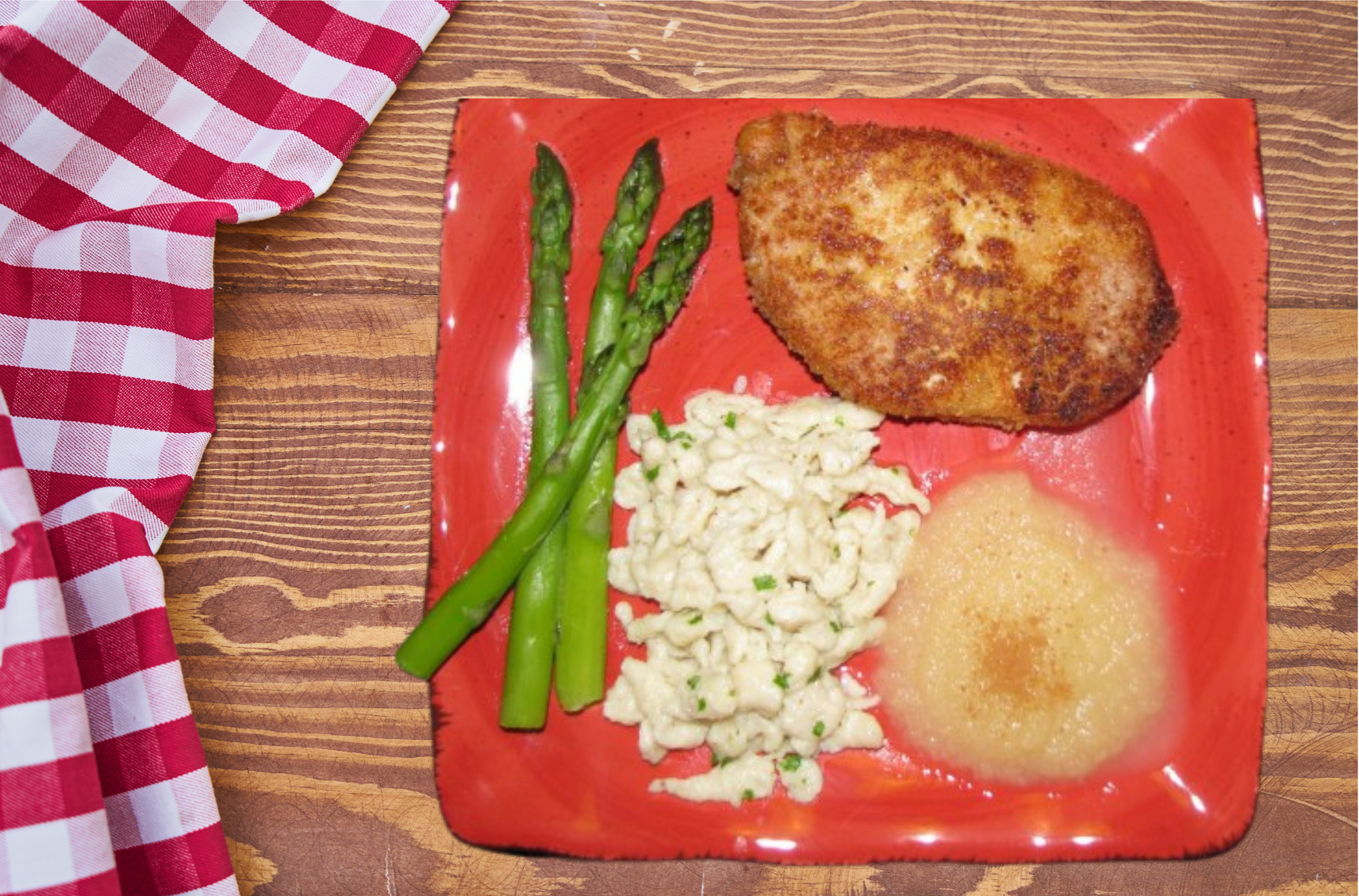
Schnitzel Ingredients:
- 1 pound pork cutlets
- Salt and pepper
- 1/2 cup flour
- 2 eggs, beaten
- 1 cup dry bread crumbs
- Cooking oil
Preparation:
- Pound cutlets until they are thin.
- Sprinkle cutlets with salt and pepper.
- Set out three plates, the first with the flour, the second with the beaten egg and the third with the bread crumbs.
- Coat each cutlet first with flour, then cover both sides with egg, then coat with bread crumbs until completely covered.
- Heat a 1/4 inch of oil in a skillet over medium high heat.
- Add breaded cutlets.
- Cook until dark golden brown.
- Drain on paper towel and serve.
Spaetzle
Literally translated from German as "little sparrow," spaetzle are small irregularly shaped noodles made with flour, eggs, water or milk, salt and sometimes nutmeg. There are two main ways to make spaetzle, the more traditional way by slicing small slivers off of a flattened piece of firm dough or by forcing batter through a sieve or colander that has large holes. There are also spaetzle-making machines. The recipe below uses the force-through-a-colander method.
Ingredients:
- 3 cups of flour
- 4 eggs
- 1 cup of milk
- 1 tablespoon of salt
- 2 tablespoon of finely chopped parsley (optional)
- 2 tablespoons of butter (to taste)
Preparation:
- Fill a large wide pot 3/4 full of salted water and bring to a rolling boil.
- Mix the flour, salt, eggs and parsley in a mixing bowl.
- Stir in milk slowly until a thick batter forms.
- Let batter sit for 5 minutes.
- The batter should be thick, just before it reaches the thickness that it will no longer pour from the mixing bowl.
- This part is a bit tricky; it requires more hands than most people have and you will be working over a boiling pot of water.
- Hold the large-holed colander over the pot and pour about a cup of batter into the colander.
- Using a spoon or the bottom of a glass, force the batter through the holes.
- The batter will float to the top of the pot, stop adding more batter when the top of the water is covered.
- Boil for 5-8 minutes.
- Remove Spaetzle with a large slotted spoon and then drain further through a stainer.
- Repeat the cooking process until all the batter is used.
- Mix with butter and serve.
- Details
- Hits: 3779
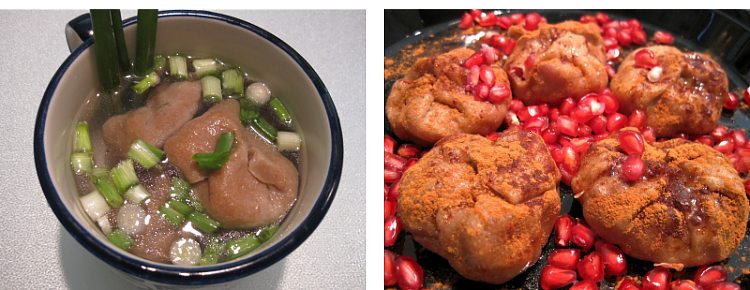
Photos: Jessica Price Varenyky is a Ukrainian dumpling and makes for a very versatile dish. The possibilities are endless which makes this a great choice for vegetarian, meat eaters and dessert lovers alike! Enjoy!
Varenyky Dough Ingredients:
- 5 1/2 cups flour
- 1 egg
- 1 3/4 cups warm water
- 1/2 teaspoon salt
- 1 tablespoon oil
Preparation:
- In a large mixing bowl, combine 3 cups flour with egg, warm water, salt and oil. Mix well.
- Knead in the remaining flour. Knead until smooth and pliable. Let stand 10 minutes.
- Cut into pieces, and roll flat (1/8 inch thickness).
- Cut circles in the dough using a drinking glass.
- Continue rolling and re-rolling dough until you have as many circles as possible, using additional flour if needed to keep the dough from sticking.
- Take a dough circle in your palm and scoop in a small spoonful of filling.
- Dip your fingers into a little water, fold over and press edges together.
- Repeat this process until all of the dough is used.
This recipe yields many varenyky, but you may store them in the freezer until ready to use.
Savory Filling Ingredients:
- 1/4 cup green onions (scallions), finely chopped
- 1/2 red onion, finely chopped
- 2 cloves of garlic, finely chopped
- 1/2 package ground soy sausage or pork sausage if preferred
- 1 tablespoon olive oil
- Dash of salt
- 1/2 teaspoon pepper
Preparation:
- In sauté pan, warm oil on medium heat and add green and red onion.
- When onions have softened, add garlic and sausage, using a fork to break up and mix filling.
- Add salt and pepper to mixture. Cook for an additional 3 minutes, or until pork sausage is cooked, and then filling is ready go in the dough.
Sweet Filling Ingredients:
- 1 apple, finely chopped
- Seeds from 1 medium sized pomegranate
- 1 tablespoon butter
- 2 tablespoons cinnamon
- 1 tablespoon brown sugar
Filling Preparation:
- Add 1/2 tablespoon of butter to medium heated sauté pan.
- Add chopped apples and cook until slightly browned and soft.
- Add pomegranate seeds and sprinkle mixture with 1 tablespoon of cinnamon. Continue cooking until both the apple and pomegranate are heated through. Filling is ready to be added to the dough.
- Add up to 6 varenyky to a pot of salted, boiling water.
- Boil 4-5 minutes, until cooked through and floating.
If the varenyky are savory, transfer to frying pan with butter or oil and chopped onions and cook until crispy. Serve with a dollop of Smetana or sour cream. Another serving option is placing 1 or 2 dumplings in a broth soup. If the varenyky are sweet, transfer to frying pan with the other tablespoon of butter, cinnamon, and brown sugar. Serve warm.
As mentioned earlier, have fun with this recipe and get creative!<
Recipe submitted by Jessica Price
- Details
- Hits: 3592
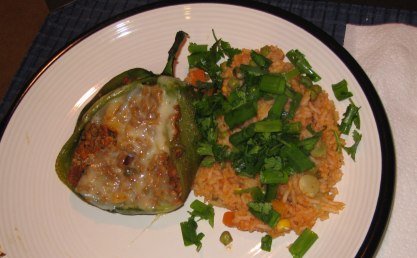
"Tex-Mex" is a blend of Mexican and southwest U.S. cultural elements. The term when applied to food typically indicates a method of preparing traditional Mexican foods with ingredients more commonly available in the United States. There are many variations of this dish, this is based on the one my grandmother made. This recipe serves two, but it can be doubled to serve more.
Ingredients:
- 2 Poblano (Mexican) peppers
- 1 tablespoon of olive oil (for vegetarian version)
- 3/4 pounds ground beef (may substitute crumbled vegetarian burger)
- 2 tablespoons McCormick chili seasoning mix or Mexican Adobo spices (more or less according to taste)
- 2 celery sticks, minced
- 2 or 3 garlic cloves, minced
- 1/2 small onion, minced
- 1/4 cup shredded pepper jack cheese or Mexican Asadero cheese
- salt & pepper to taste
Preparation:
- Preheat oven to 375 degrees
- Pablano peppers are typically charred until black over an open flame from either a gas stove or over a grill. They can also be broiled in an oven. The goal with the charring is to fully cook the peppers. Another method is to parboil the peppers for 3 minutes. Peppers can be eaten with their skins or they can be easily removed once they are either grilled or parboiled.
- Slice the Pablanos in half lengthwise and remove the seeds
- In a large (preferably cast-iron) skillet brown hamburger and then add the garlic, onion celery, spice mixture, salt and pepper. Saute until onions are translucent. If you are cooking the vegetarian version, saute all the ingredients in the olive oil.
- Arrange the pepper halves on a cookie sheet or oven pan. Brushing the pan lightly with olive oil will prevent the peppers from sticking.
- Fill Pablano pepper halves with the above mixture and generously top with shredded cheese.
- Bake stuffed peppers for 10 minutes or until the cheese melts and starts to brown
Stuffed peppers can be served with Mexican or white rice and either re-fried or black beans. Enjoy!
Recipe by Angela Basurtto
- Details
- Hits: 4353
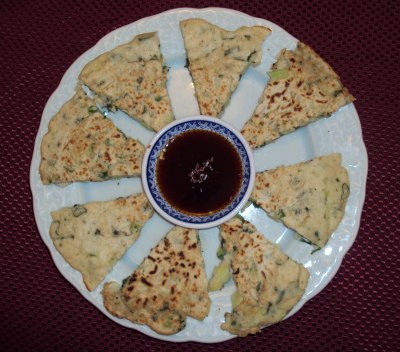
Pa jun is traditional Korean-style savory pancake with is enjoyed with a dipping sauce. While eaten throughout the year, it is a particular favorite for the Korean harvest holiday Chuseok, a three-day holiday celebrated on the 15th day of the 8th month of the Korean lunar calendar. It is a time for honoring ancestors, sumptuous feasts and the playing of traditional games and sports such as archery, ssireum (Korean version of sumo wrestling) and tug-of-war. Other foods popular at Chuseok include bulgogi (grilled marinated beef), japchae (stir-fried cellophane noodles) and songpyeon, a rice cake steamed on top of pine needles.
Ingredients:
- 2 cups of flour
- 2 cups of water
- 2 eggs
- 1 bunch of scallions (use green parts only)
- vegetable oil
- salt & pepper to taste * Please note that this is the basic recipe for pa jun. The dish can enhanced by adding finely chopped vegetables (asparagus, broccoli, green beans) or chopped cooked leftover meat (chicken, beef, pork).
Dipping Sauce:
- 3 tablespoons rice wine vinegar
- 3 tablespoons soy sauce
- 1 1/2 teaspoons sugar (optional)
- pinch of hot red pepper flakes
Preparation:
- In a large bowl, mix flour, water and egg and beat until smooth. Add more flour or water if needed to get the consistency of a thin pancake batter.
- Stir in the finely chopped scallions and season with salt and pepper.
- Heat a well-oiled skillet over medium flame. Pour about 3/4 cup batter into the skillet, tilting the pan to cover the bottom.
- Cook pa jun for 6-8 minutes until the bottom is lightly brown, then flip and brown the other side.
- Remove pa jun from pan, cut into wedges and serve with the dipping sauce.
Enjoy!
Recipe submitted by: Soo Hyun Lim (aka "Alice")
Photo by Shari K. Johnston-O'Neill
- Details
- Hits: 4316
Joomla!
Extensions
The Joomla! content management system lets you create webpages of various types using extensions. There are 5 basic types of extensions: components, modules, templates, languages, and plugins. Your website includes the extensions you need to create a basic website in English, but thousands of additional extensions of all types are available. The Joomla! Extensions Directory is the largest directory of Joomla extensions.
Components
Components are larger extensions that produce the major content for your site. Each component has one or more "views" that control how content is displayed. In the Joomla administrator there are additional extensions such as Menus, Redirection, and the extension managers.
Modules
Modules are small blocks of content that can be displayed in positions on a web page. The menus on this site are displayed in modules. The core of Joomla! includes 24 separate modules ranging from login to search to random images. Each module has a name that starts mod_ but when it displays it has a title. In the descriptions in this section, the titles are the same as the names.
Content Modules
Content modules display article and other information from the content component.
User Modules
User modules interact with the user system, allowing users to login, show who is logged-in, and showing the most recently registered users.
Display Modules
These modules display information from components other than content and user. These include weblinks, news feeds and the media manager.
Utility Modules
Utility modules provide useful functionality such as search, syndication and statistics.
Navigation Modules
Navigation modules help your visitors move through your site and find what they need.
Menus provide your site with structure and help your visitors navigate your site. Although they are all based on the same menu module, the variety of ways menus are used in the sample data show how flexible this module is.
A menu can range from extremely simple (for example the top menu or the menu for the Australian Parks sample site) to extremely complex (for example the About Joomla! menu with its many levels). They can also be used for other types of presentation such as the site map linked from the "This Site" menu.
Breadcrumbs provide users with information about where they are in a site.
Page 18 of 28









